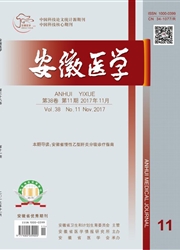

 中文摘要:
中文摘要:
目的:分析安徽地区不动杆菌感染的临床分布及耐药特点,为临床诊断和治疗提供依据。方法653株不动杆菌药敏试验采用琼脂稀释法,依据CLSI 2010年推荐的标准进行结果判读。结果不动杆菌在痰及呼吸道分泌物标本中检出率最高,达81.6%;主要分布于重症监护病房、呼吸内科、神经内科以及老年病科等;药敏结果显示,不动杆菌对大多数抗菌药物的敏感率均不理想,最敏感的为亚胺培南和美罗培南,但敏感率也仅为50.0%左右;对其他抗菌药物的耐药率均小于40%;对三、四代头孢菌素的耐药率均在60.0%左右;对庆大霉素和阿米卡星的耐药率为59%和51%;在环丙沙星、左氧氟沙星、加替沙星3种氟喹诺酮类中,以加替沙星的耐药率最低,耐药率45.8%。结论不动杆菌常引起医院感染,耐药现象严重,临床抗感染治疗应依据体外药物敏感试验结果合理选择抗菌药物,同时应加强对不动杆菌耐药性的监控并防止耐药菌株的传播流行。
 英文摘要:
英文摘要:
Objective To analyze the clinical distribution and antimicrobial resistance of Acinetobacter spp.in Anhui province in or-der to provide the scientific evidence for clinical diagnosis and treatment.Methods The antimicrobial susceptibility test of 653 strains of Acinetobacter spp.was performed by agar dilution method.The test results were judged according to the criteria recommended by CLSI 2010. Results The isolating rate of Acinetobacter spp.from specimen of respiratory tract was the highest,accounting for 81.6%.Acinetobacter spp.strains mainly distributed in Intensive Care Unit、Respiratory Department、Neurology Department and Geriatrics Department.The results of drug susceptibility test showed that Acinetobacter spp.was highly resistant to most antimicrobial agents.The most sensitive drug were imi-penem and meropenem,but the sensitive rates were only about 50.0%.The resistant rates to other antimicrobial agents were higher than 40.0%;about 60.0% to the third and fourth generation cephalosporins;59.4% and 51.8% to gentamicin and amikacin,respectively;the resistant rate to gatifloxacin was the lowest in the three kinds of fluoroquinolones,which was 45 .8%.Conclusion Acinetobacter spp.is a major opportunistic pathogen during hospital infections,and resistant to many kinds of antimicrobial agents.The reasonable use of antimicrobi-al agents should be based on the result of susceptiblity test,at the same time,the surveillance of drug resistance in Acinetobacter spp.should be strengthened in order to prevent the spread of resistant strains.
 同期刊论文项目
同期刊论文项目
 同项目期刊论文
同项目期刊论文
 Prevalence of plasmid-mediated quinolone resistance determinants in association withb-lactamases, 16
Prevalence of plasmid-mediated quinolone resistance determinants in association withb-lactamases, 16 Stenotrophomonas maltophilia resistance to trimethoprim/ sulfamethoxazole mediated by acquisition of
Stenotrophomonas maltophilia resistance to trimethoprim/ sulfamethoxazole mediated by acquisition of Detection of the plasmid-mediated quinolone resistance determinants and the emergence of multidrug r
Detection of the plasmid-mediated quinolone resistance determinants and the emergence of multidrug r Surveillance of Antimicrobial Susceptibility Patterns among Shigella 5 Species Isolated in China dur
Surveillance of Antimicrobial Susceptibility Patterns among Shigella 5 Species Isolated in China dur 期刊信息
期刊信息
